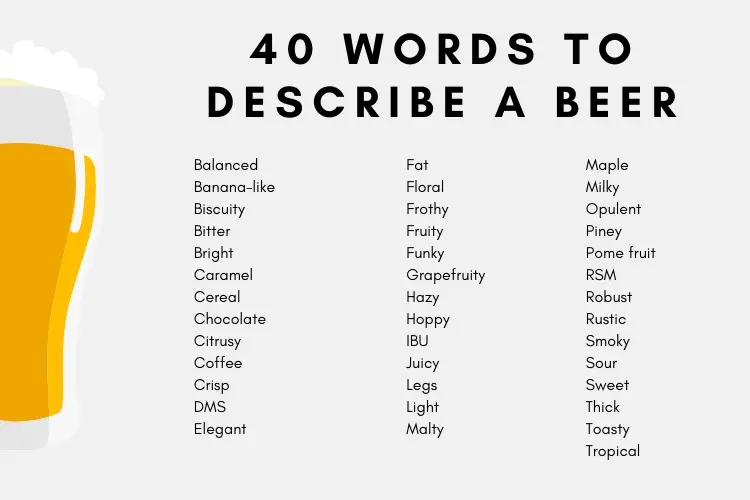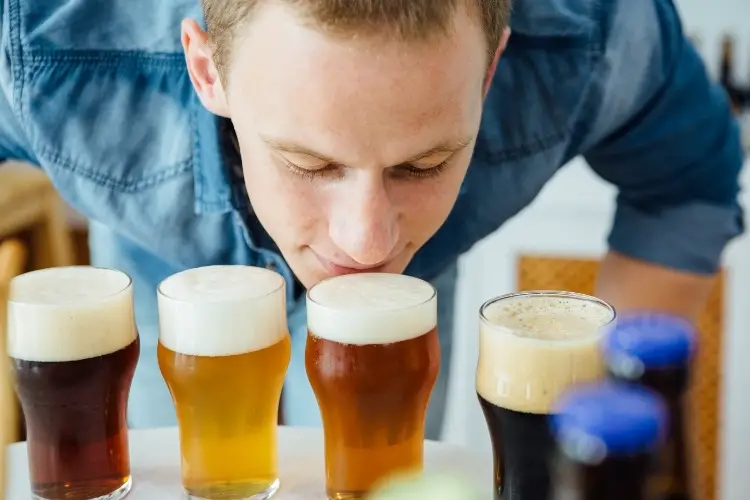Beer might be easy to enjoy, but it’s a complex drink. There are countless styles, each showing unique flavors, textures and aromas.
This means, to increase your enjoyment further, you must be able to describe beer adequately, which also means you should learn a few terms experienced beer drinkers, beer judges and brewers use.
The better you understand your favorite brew, the more you’ll enjoy it, and although mastering beer’s vocabulary can seem challenging, there are few topics more enjoyable to study!
Here are 40 words to best describe your beer and sound like a pro.

1) Balanced
Beers balanced between maltiness and hoppiness, bitterness and alcoholic strength.
Balance is a matter of perception and can vary from taster to taster.
Although a balanced beer is perceived as of higher quality, many beer styles are purposely unbalanced, like IPAs, which are hop oriented, and they’re very enjoyable.
2) Banana-like
Wheat beers tend to have banana-like aromas proper of the yeast used in the style.
European wheat beers might have more banana aromas than others.
3) Biscuity
The very same aromas one could expect in a bakery.
Yeast, bread dough, biscuit, flour and cookies.
These aromas are traditional in British roasted malts.
Ex: Ordinary Bitter, Festbier, British Brown Ale.
4) Bitter
Bitterness is essential in beers, and it’s present in all styles.
Bitterness comes from the hops used to stabilize and aromatize the beer.
It is measured in IBUs or International Bitter Units.
The hoppier the beer, the bitter it is.
Try Double IPAs or Imperial IPAs for the most bitterness.
5) Bright
Brightness might refer to the beer’s color.
A clear, translucent, perhaps golden beer can be described as bright.
Brightness is also found in beer’s flavor and aromatic profiles.
Crisp, refreshing, zippy, and well-defined beers are definitely bright.
6) Caramel
Beers based on roasted malts, including Vienna, Munich or ‘caramel’ malts.
Caramel flavor and aromatic compounds are produced in the roasting process thanks to the Maillard reaction in which carbohydrates and simple sugars are literally caramelized.
7) Cereal
Beers with perceivable cereal flavors and aromas coming from the grain bill, often heavy on pale Pilsner malts or other lightly toasted malts.
Oats and wheat can also add cereal-like scents to the beer.
8) Chocolate
A common descriptor for beers made with heavily roasted malts such as stouts and porters.
Certain specialty beer might indeed have chocolate or cacao as an ingredient.
9) Citrusy
Perceivable aromas reminiscent of lemons, limes, tangerines or oranges.
Common in beers with lots of New World hops or that have been dry-hopped with particularly citrusy hops.
You’ll find these scents in IPAs and some pale ales.
10) Coffee
The unmistakable scent of freshly roasted coffee or espresso is quite common in stouts and porters.
Beers made with dark roasted malts.
You might also find a chocolate aroma in these beer styles.
11) Crisp
Crisp is a beer term hard to describe.
It might refer to refreshing, bright, zippy, well-defined or tart beers.
Crisp is a positive descriptor and is commonly used for lively beers.
12) DMS
Short for Dimethyl Sulfide, a beer flaw that smells like canned corn.
When not intrusive, it can be delightful.
It’s common in beers made with Pilsner malts.
13) Elegant
Clean, smooth, balanced beers with no noticeable flaws or overwhelming aromas.
Usually crisp and light with stratified flavors and aromas along with a refined mouthfeel.
14) Fat
Fat beers are often palate coating and thick with robust flavors and aromas.
They might be hoppy or malty, but always over the top.
High alcohol and high glycerin levels might help a beer feel fatter than others.
15) Floral
Scents reminiscent of flowers are usually found in beers fermented with noble European hops, which are earthy, spice and flowery instead of fruity.
Beers based on pale malts tend to be more flowery than dark, malty beers.
16) Frothy
Frothy beers tend to have foamy heads or collars.
Lots of carbonation and persistent bubbles.
The more protein in the wort and the more yeast and hop residues in beer, the frothier a beer can be.
17) Fruity
Beers fermented with ale yeast or top-fermented yeast produce esters, or aromatic compounds often described as fruity.
18) Funky
Funky beers are often fermented with wild yeast and are common in Old World countries.
Brett and acidity might be present, and they can be pleasing or utterly disgusting.
19) Grapefruity
From all the fruit descriptors found in beer, grapefruit aromas are some of the most easily identifiable.
Commonly found in citrusy beers dry-hopped with New World hops.
Common grapefruity styles are IPAs.
20) Hazy
Any beer that’s not crystal clear or translucent could be considered hazy.
These are commonly based on wheat grains, and they’re unfiltered.
Hazy beers might have a fuller mouthfeel than clear ones.
Hazy IPAs are tremedously trendy these days.
21) Hoppy
Beers with noticeable hop aromas reminiscent of herbs, flowers or fruits.
Also, noticeable bitterness from hops.
Hoppier beers are not always better.
Some styles are naturally hoppy, like IPAs, while others are prized for being balanced between hoppiness and maltiness.
22) IBU
International Bitterness Units.
Typically ranging from 5 in commercial lagers to over 60 in IPAs.
Experimental beers can have significant IBUs of over 1000, although an average beer drinker can only taste up to 60 IBU while still perceiving a difference in bitterness.
23) Juicy
Many types of beers can be described as juicy.
Some experimental beers might indeed have some fruit juice as an ingredient.
Still, more often than not, juicy beers, like Hazy IPAs, are perceived as juicy for their thick mouthfeel, almost always coming from wheat and a hefty addition of tropical-scented hops.
24) Legs
Running drops that develop inside a glass.
They’re indicative of high levels of glycerin and/or alcohol.
They’re not necessarily related to beer’s quality.
25) Light
The descriptor might be used when describing a low-calorie, low-alcohol beer, but regular beers can be light as well if the mouthfeel is the opposite of thick or coating.
The term might also be used to describe beers that are light in color.
26) Malty
Beer styles with bread, malt and yeast aromas with less noticeable hop influence.
Most dark beers are malty, including amber lagers, brown ales, porters and stouts.
27) Maple
Although adding maple syrup to the wort is not unheard of, you can find maple aromas in beer for several reasons.
One is aging the beer in maple wood vessels.
The other occurs when a chemical compound called sotolon forms in the beer, more often than not because of purposely or accidental oxidation.
28) Milky
Thick, creamy beers can be perceived as milky, often unfiltered wheat-based malts.
Some producers might also add lactose to their beers, giving them milky traits common in chocolate porters and milkshake stouts.
29) Opulent
Opulent beers are big and bold, often with layered flavors and complex aromas.
High alcohol and glycerin levels, as well as the use of wheat in the beer, might add opulence to a beer.
30) Piney
The distinctive flavor and aroma of pine resin are typical in many beers, mostly the ones with large amounts of hops or that have been dry-hopped extensively.
Chinook, Simcoe and Mosaic hops are known for being particularly piney.
31) Pome fruit
Apples, pears, quince, loquats and medlars.
Ex: Scottish Heavy, Trappist Single, Gose.
These aromas are common on European beer styles that are not tropical fruit oriented.
32) RSM
The Standard Research Method is a number scale that describes the beer’s color, or more precisely, the amount of light lost when reflected in the beer.
Beers with high RSM levels of 30 or more are almost black.
Light beers might have an RSM of 2 or 3.
33) Robust
Robust beers are rich, full-bodied and have a strong mouthfeel, flavor and alcohol profile.
34) Rustic
Beers of robust character, often coarse, hearty and perhaps hazy and funky.
Rough on the edges and less refined but might be quite pleasing.
Ex: California Common, Saison, Pre-Prohibition Lager.
35) Smoky
Some beers are actually treated with smoke, including the German Rauchbier, but others are smoky for being aged in toasted oak barrels or simply use a particularly smoky malt.
36) Sour
Sourness is not that common in beers, but certain styles, including a few Belgian and French beers, have perceivable tanginess, sourness or acidity.
The sourness often comes from wild yeasts and other microorganisms that feed on the wort.
Gose, Lambic and Gueuze are types of sour beers.
37) Sweet
Beers with noticeable residual sugar.
These refer to sweetness in the palate and not sweet fruit or honey aromas.
Most beers will have little to no sweetness as the yeasts consume the sugar to produce alcohol and gas.
Excess sweetness can be considered a flaw, a product of stuck fermentation, but some styles are naturally sweeter.
38) Thick
Both dark and light beers can have a thick character.
It often depends on the amount of alcohol and glycerin in the beer.
Malty beers or beers with added adjuncts such as lactose or oats can be thick too.
These beers have a coating mouthfeel.
39) Toasty
Beers based on toasted, caramel or chocolate malts.
The darker the beer, the toastier it might be.
Amber lagers, dark ales, porters and stouts might be toasty.
40) Tropical
Tropical fruits are common in beers using New World Hops known for their fruit aromas.
Bananas, lychee, passionfruit, pineapple and mango are common tropical fruit aromas found in beer like New England IPA.

